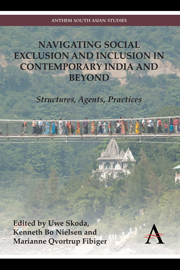 Navigating Social Exclusion and Inclusion in Contemporary India and Beyond
Navigating Social Exclusion and Inclusion in Contemporary India and Beyond Book contents
- Frontmatter
- Contents
- Acknowledgements
- List of Contributors
- 1 Introduction: Navigating Exclusion, Engineering Inclusion
- Part I Spaces and Values
- Part II Communities and Politics
- Part III Resources and Development
- 10 Dams, Development and the Exclusion of Indigenous Groups: A Case from Odisha
- 11 ‘Solutions Emerge When Everyone Works Together’: Experiences of Social Inclusion in Watershed Management Committees in Karnataka
10 - Dams, Development and the Exclusion of Indigenous Groups: A Case from Odisha
from Part III - Resources and Development
Published online by Cambridge University Press: 05 September 2013
- Frontmatter
- Contents
- Acknowledgements
- List of Contributors
- 1 Introduction: Navigating Exclusion, Engineering Inclusion
- Part I Spaces and Values
- Part II Communities and Politics
- Part III Resources and Development
- 10 Dams, Development and the Exclusion of Indigenous Groups: A Case from Odisha
- 11 ‘Solutions Emerge When Everyone Works Together’: Experiences of Social Inclusion in Watershed Management Committees in Karnataka
Summary
Mega-dam building in India in the post-independence era became a major symbol of modernization. Even today, the mega-dam continues to be seen as a symbol of progress, of man's supremacy over nature, of prosperity and of pride. However, due to construction of dams, many indigenous communities are displaced involuntarily and compensated marginally. It severely damages the rich sociocultural fabric of the marginalized people. In this process, the indigenous people suffer from economic and social marginalization in many important areas of community life. The rehabilitation and resettlement policies have often further marginalized the already marginalized people from life's opportunities. This has deprived this segment of the population from the rights and privileges enjoyed by the dominant sections of society. Countless studies and reports have documented that the interests of ‘development oustees’ were rarely taken into consideration when mega projects were built (Oliver-Smith 1991; Thukral 1992 and 1996; Parasuraman 1993 and 1999; Scudder 1996; Colson 1999; WCD 2000). Indigenous people seldom understand the long-term implications of development projects, and hence fail in their efforts to devise measures to counter them.
Recognizing this problem, World Bank sociologist Michael Cernea developed the highly influential Impoverishment Risks and Reconstruction (IRR) model (see Cernea 1994, 1997, 1998, 1999, 2000) now widely used in resettlement research (for example, Mathur and Marsden 1998). This model has been key in showing how displacement goes hand in hand with physical, social and economic exclusion.
- Type
- Chapter
- Information
- Navigating Social Exclusion and Inclusion in Contemporary India and BeyondStructures, Agents, Practices, pp. 167 - 188Publisher: Anthem PressPrint publication year: 2013


